
Originally published in The Clarinet 50/2 (March 2023).
Printed copies of The Clarinet are available for ICA members.
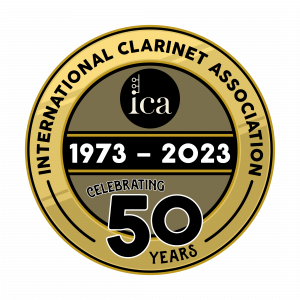
The ICA at 50: Refining the Mission, 1992–2002
This article is the second in a four-part series documenting the history of the International Clarinet Association, in celebration of its 50th anniversary in 2023. Part 1 appeared in The Clarinet 50, no. 1 (December 2022). Readers are also referred to Alan Stanek’s extensive history written for the 40th anniversary in 2013, which may be read on the ICA website (clarinet.org/history), and to The Clarinet 40, no. 3 (June 2013), which contains numerous articles and remembrances commemorating the ICA’s 40th anniversary.
by Jane Ellsworth
At the beginning of its third decade, the International Clarinet Association was a thriving organization that, nevertheless, had plenty of room for growth and change. The decade from 1992 to 2002 saw the ICA examining and refining its mission, growing its membership, instituting new competitions, continuing to work toward a truly international presence through ClarinetFest® and the journal The Clarinet, and finding its footing in the new internet era.
Administrative and Policy Matters
The ICA was led into its third decade by President Howard Klug, who declared himself to be “the education president” (poking fun at the US president of the time, George H. W. Bush, who used the same moniker). Indeed, a focus on enhancing the educational mission of the ICA was a theme that characterized much of the period from 1992 to 2002. Klug strongly advocated for “the creation of new educational programs for young students and an expansion of the membership to include more young professionals, public school students and amateurs of all ages.”1 He encouraged the formation of local clarinet clubs and clarinet choirs, and offered to send a packet of information to interested members about how to set these up. To implement some of his ideas, Klug made changes to the structure of the ICA’s competitions, creating a separate high school competition with an age limit of 19, and raising the age limit of the young artist competition to 26. A further innovation was the creation of a composition competition—separate from the ICA’s already-existing commissioning project—spearheaded by Michele Gingras of Miami University in Ohio, who would continue to run the competition for the next decade.
At the same time, Klug worked to increase ICA membership. In the first year of his term the organization had been hovering just below 3,000 members, so a large and well-organized membership campaign was launched at the beginning of 1994, led by President-Elect Gerry Errante and closely involving all of the ICA’s state and regional chairs. The goal was to get up and over the 3,000 threshold, a goal that was met by the time of the annual business meeting in July 1994, when an 8% increase to 3,124 was reported. A new Adopt-A-Member program was also instituted, through which current members could sponsor new members who otherwise wouldn’t be able to join.
Gerry Errante, ICA president from 1994 to 1996, continued to promote educational initiatives such as regional clarinet clubs, adding to them his own commitment to helping members in countries outside North America in forming clarinet societies affiliated with the ICA. The ICA’s network of national chairs, which had been in place since the beginning, also continued to expand, with new chairs added for Israel, Mexico, and (by the end of Errante’s presidency) Thailand, Brazil, New Zealand, Hong Kong, Ireland, Armenia, Italy, and South Africa. Along the same lines, Errante also promoted the Adopt-A-Member program, and during his term he visited many countries, from Australia to Zimbabwe, to forge bonds with clarinetists and promote the ICA.
Errante initiated two other projects that would ultimately take several years and multiple presidents to complete: an anthology of important writings about the clarinet from publications that may be out of print or difficult to find (Keith Koons took charge of this); and a recording project, which “possibly could include highlights of performances at ClarinetFest or it could take the form of a series of CDs compiled from recordings of unusual repertoire submitted by ICA members.”2 And because of an unfortunate event, the death of former ICA President Jerry Pierce, Errante started the multi-year process of incorporating Pierce’s vast music collection into the ICA’s library at the University of Maryland.
It was also during the presidencies of Klug and Errante that the ICA took its first steps into the age of electronic communication. In the era before the World Wide Web, an information service called Klarinet was set up using Bitnet in 1992. The original administrator for the service was James Fay of Northern Virginia Community College.3 Though it gained little attention at first, by the spring of 1995 Errante announced that the ICA would use Klarinet to facilitate more rapid communication. An ICA internet liaison was named, David Niethamer, who would make ICA postings on Klarinet. As Errante stated, “for those of you with a computer and a modem and who have not already done so, I urge you to enter the ‘information superhighway.’”4
A look at the minutes of the last business meeting of Errante’s term, as well as his presidential messages from 1994, shows that the ICA membership now numbered 3,374, with 82% of members residing in North America and 18% outside. A highlights CD from the 1995 ClarinetFest® was available, and the first CD in the series featuring ICA members was underway. Successful ClarinetFest® conferences had been held in Tempe, Arizona, and Paris, France, with upcoming conferences planned for Lubbock, Texas (1997), Columbus, Ohio (1998), and Ostend, Belgium (1999). And all the ICA officers had email addresses!
As many of us remember, things moved fast in the early days of electronic media and communication, and by the end of Errante’s presidency the possibilities of the internet for hosting large amounts of information were beginning to be explored. It was decided that the best format for the ICA’s anthology project would not be in print, but online. The ICA’s website came into being during the term of Alan Stanek, who served as president from 1996 to 1998. The initial webmaster was Stan Geidel. Stanek frequently commented on the internet in general, and the ICA’s website in particular, in his presidential messages, noting the new potential not only to foster a lively exchange of information within the clarinet world, but also to inform clarinet enthusiasts of the existence of the ICA. Indeed, less than a year into Stanek’s presidency it had already helped garner more ICA members.5 By the middle of Stanek’s term, membership stood at almost 3,900, including a 16% increase in members outside of North America.

At ClarinetFest® 1998 in Columbus, Ohio
The ICA presence on the internet was not the only new idea during Stanek’s presidency. The ICA board had for a number of years been discussing the relationship between the ICA and the ClarinetFest®, and particularly how the ICA might work to aid ClarinetFest® hosts in the huge task of mounting this annual conference, ensuring the membership of a well-organized and artistically satisfying experience. Such conversations became more prominent during Stanek’s term, including the idea that the ICA “actually run and be responsible for the myriad details of future conferences.” At first, the idea was that ICA members themselves would “serve on committees to select the featured performers, plan and coordinate research sessions, invite and coordinate the exhibit area for our music merchandisers, and plan for social events.”6 But the possibility of using a professional conference organizer had also been discussed at the officers’ meeting in the summer of 1996.7
Ongoing projects made further progress during Stanek’s presidency. The CD project featuring ICA members produced the first of three CDs which, however, sold very slowly. Keith Koons, working with ICA attorney Bud Rubin, obtained copyright permissions for the reprinting of the first eight articles on the online anthology. A new electronic newsletter, produced first by Stan Geidel and then by Roger Garrett, gained popularity. In the summer of 1998 the ICA board inserted a survey in The Clarinet to gather data on membership demographics, internet access, use of the ICA Research Collection, general interests, willingness to volunteer, and interest in the CD project. A lifetime achievement award and honorary membership was set up and awarded for the first time at the Columbus ClarinetFest®, with early figures from the ICA’s history—Ralph Strouf, Ramon Kireilis, and Lee Gibson—as the initial honorees. By the end of Stanek’s term the ICA had reached its goal of topping 4000 members. A fitting celebration of the organization’s 25th anniversary!
Robert Spring took over as ICA president for the period 1998–2000. Like his immediate predecessors, Spring aimed to increase the ICA’s outreach to younger players and public school teachers. One of his plans was to include a separate flyer or supplement in The Clarinet containing material focused on teaching clarinetists at the junior high and high school levels. Meanwhile, the ongoing consideration of the ICA’s role in facilitating ClarinetFest® began to turn from discussion to action. The board took two small but significant steps to aid future ClarinetFest® hosts. First, it directed a significant updating of the conference handbook, including the stipulation that “hosts will work closely with the ICA Board in the scheduling of events and selection of artists, the planning of conference fees, and that [sic] hosts will abide by the conditions as outlined in the Conference Handbook.” Secondly, it approved the establishment of the position of exhibition coordinator. This action not only relieved ClarinetFest® hosts of the time-consuming function of organizing this important aspect of the conference, but also helped to establish a more consistent and productive relationship with the ICA’s partners in the music industry. Gary Whitman was appointed as the first exhibition coordinator.
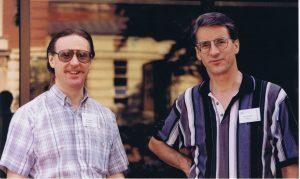
Then-president of the ICA, Robert Spring, and past president Charles West at ClarinetFest® 1998 in Columbus, Ohio
In keeping with the plan to offer ClarinetFest® on a three-year rotation that included every third year outside North America, locations were chosen for the years 2000 (University of Oklahoma), 2001 (New Orleans), and 2002 (Stockholm, Sweden). In his “President’s Message” of December 1999, Spring noted that conference attendance had grown to the point where university campuses were not always large enough as venues, and that the ICA would start to consider hotels and convention centers as potential sites. Thus, the 2001 ClarinetFest® would be held largely within the precincts of the New Orleans Hilton Hotel.
Spring also oversaw the completion of an online catalog for the ICA Research Library at the University of Maryland. This process had taken a number of years, but promised to make the library’s contents much more accessible to the membership. Other accomplishments during Spring’s presidency included the establishment of criteria and procedures for future Honorary Membership Awards, the bestowal of that award on George Waln, Guy Deplus, Jack Brymer, and Himie Voxman, and the successful completion of the ICA’s CD project—three CDs in total, which were offered as a package and had sold out by September of 2000. Coinciding with the end of Spring’s term was the resignation of Elena Lence Talley as membership coordinator, a position in which she had effectively served for 10 years. Rose Sperrazza was hired to fill the position.
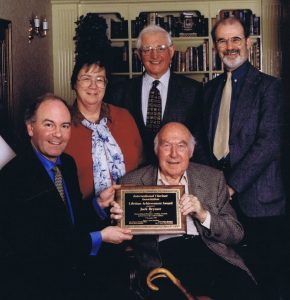
David Campbell, Angela Fussell, Jack Brymer (seated), Colin Bradbury, and Ian Mitchell, on the occasion of Brymer’s Honorary Membership Award in 1999
Julie DeRoche carried the ICA into the new millennium, serving as president from 2000 to 2002. Under her leadership, significant progress was made in a number of business matters. To manage the ICA’s finances, a new accounting system was put in place. The board decided to further help ClarinetFest® hosts by providing $5000 for printing, mailing, publicity costs, and the like. Also under consideration was the idea of hiring a conference coordinator to handle logistics and organization, to allow hosts to focus on artistic and programmatic matters. The first experiment along these lines was for the Stockholm ClarinetFest® in 2002, where a conference coordinating firm was hired to handle mailings, advertising, travel arrangements, and housing.
Other initiatives during DeRoche’s presidency included the setting aside of $5000 to be used as grants for projects by the membership; the discontinuation of the composition competition and the redirection of that prize money toward commissions from established or up-and-coming composers; and the elimination of two membership categories, joint and international. New ideas for the ICA website, now with Mark Charette as webmaster, included a bulletin board, a members-only section, a function to allow members to chat with ICA officers, the posting of articles/abstracts/presentations, and the possibility of renewing memberships online. Honorary Membership Awards were given to Stanley Hasty, William O. Smith, Alfred Prinz, Mitchell Lurie, and Paul Harvey. In sum, DeRoche oversaw much-needed changes that allowed the ICA to continue to improve as an organization, and to enhance its benefits to members.
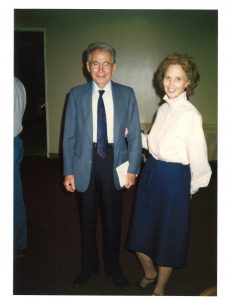
Himie Voxman and his wife Lois at the time of his
Honorary Membership Award in 2000
The Clarinet
The ICA’s journal, The Clarinet, continued to grow and change in positive ways during the period from 1992 to 2002. Although it has often been the largest expense in the budget, no ICA president has been willing to skimp on this essential resource. Since the beginning, the journal has included feature articles, reviews, reports, and announcements of various kinds. For the first five years, however, there was only one regular, single-author column: Lee Gibson’s “Claranalysis,” which continued to appear in nearly every issue for an astounding 28 years, ending after volume 28/1. When James Gillespie became editor in late 1978, with volume 6, he decided to include more single-authored, ongoing columns reflecting reader interests, and throughout his editorship he diligently worked to find writers for these. The first were “The Stein Corner,” by renowned pedagogue Keith Stein, and “Denmania,” by the English clarinet soloist John Denman, both beginning in volume 6/1. A “Care and Repair” column by Robert Schmidt began with volume 7/1, followed by “Swiss Kaleidoscope” (Brigitte Frick, volume 7/3), “Pierce’s Potpourri” (Jerry Pierce, volume 8/1), “Clarinet Talk” (Arthur Christmann, volume 9/1), “Record Rumbles” (Jim Sauers, volume 9/3), “Mazzeo Musings” (Rosario Mazzeo, volume 13/1), “Quintessence” (Bruce Creditor, volume 14/1), “News from Japan” (Tsuneya Hirai, volume 14/1), “Clarinet Pedagogy” (Howard Klug et al., volume 14/2), and others. Some of these were long-lived, extending into and beyond the 10-year period covered in this article, including those by Gibson, Pierce, Mazzeo, Creditor, and Hirai. The period from 1992 to 2002 saw the addition of the popular “Master Class” column (volume 22/1), the “Down Under Australian Report” by Neville Thomas (volume 23/1), “Kal’s Korner” by Kalmen Opperman (volume 23/2), “Industry Profiles” (volume 24/1), “Teaching Beginners”—later “Teaching Clarinet”—by Michael Webster (volume 25/3), “The Orchestral Clarinetist” by Anthony Gigliotti (volume 26/2), “Historically Speaking” by Deborah Check Reeves (volume 28/1), “Letter from the UK” by Paul Harris (volume 28/3), and others.
One of the functions of The Clarinet has always been to keep members abreast of clarinet news from around the world. For example, the formation of a new European association called EuroCASS (European Clarinet and Saxophone Society) was announced in late 1996; and a new German clarinet association, the Deutsche Klarinetten-Gesellschaft, was announced in early 1999. Reports on conferences of both of these organizations also appeared, along with reports on clarinet conferences in Beijing, Peru, Puerto Rico, and elsewhere.
A sadder but no less important function of the journal is to report on deaths of members of the clarinet community. Between 1992 and 2002, several key figures from the early days of the ICA passed away: Robert Schmidt (1940–1993), Robert Luyben (1916–1993), Jerry Pierce (1937–1994), and Ralph Strouf (1926–2002). Several renowned clarinetists also died in this period, and received tribute articles in The Clarinet: Harold Wright (1926–1993), Robert Marcellus (1928–1996), Rosario Mazzeo (1911–1997), George Waln (1905–1999), John Denman (1933–2001), and Anthony Gigliotti (1922–2001). An important figure from the clarinet industry, Léon Leblanc (1900–2000), also passed away.
The production of The Clarinet requires additional staff besides the editor; there has always been an advertising manager and at least one reviews editor. The year 1996 saw some changes in staff; longtime audio reviews editor Bradley Wong stepped down and was replaced by William Nichols, and John Scott was replaced by Gary Whitman as advertising manager.
ClarinetFests®
In his “President’s Message” in the winter 1993 issue of The Clarinet, Howard Klug urged ICA members to attend the ClarinetFest® in Ghent, Belgium the following summer, which would “not merely be a transplanted U.S. conference, but… a real effort to link up with clarinetists and clarinet associations throughout Europe.”8 Indeed, like the previous European ClarinetFests® in Paris (1981) and London (1984), Ghent featured many performers who had not been heard at ClarinetFests® in North America, naturally including a focus on Belgian players and repertoire. There was even CASS Day—an entire day of English performers sponsored by the Clarinet and Saxophone Society of Great Britain. Attendees were also treated by host Guido Six to a different selection of Belgian beer at the end of each evening concert, and were (for the first time) given a souvenir ClarinetFest® bag at registration.

Conference host Guido Six greets attendees after the evening concert with the “beer of the night” at ClarinetFest® 1993 in Ghent, Belgium
The 1993 ClarinetFest® was held in Chicago, hosted by Julie DeRoche and her colleagues Larry Combs and John Bruce Yeh. Highlights included several performances by jazz great Eddie Daniels; a trip to Ravinia, the summer home of the Chicago Symphony, for a concert that featured Sabine Meyer playing Weber’s First Concerto, as well as Kodály’s Dances of Galánta with solos by Chicago principal Combs; and an electrifying recital by Romanian clarinetist Pavel Cebzan, accompanied by accordion and cimbalom. This was also the first ClarinetFest® to include research presentations, as organized by Keith Koons and the ICA’s new Research Presentation Committee, supplying an important component that had been missing from previous conferences.
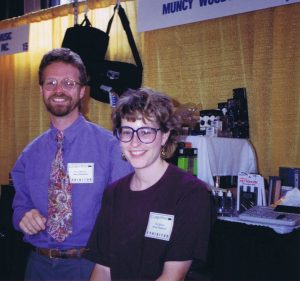
Phil and Pam Muncy at ClarinetFest® 1994 in
Chicago, Illinois
The next three ClarinetFests® were held in Tempe, Arizona (1995, hosted by Bob Spring), Paris (1996, hosted by Guy Deplus and the Quatuor de clarinettes de Paris), and Lubbock, Texas (hosted by Bob Walzel). During the 25th anniversary of the ICA, Jim Pyne hosted the ClarinetFest® in Columbus, Ohio. This was the first conference organized according to a theme: Vienna and the Clarinet. This theme allowed for a large number of performances by historical clarinet specialists such as Eric Hoeprich, Colin Lawson, Bill McColl, and Carles Riera. The modern side of Vienna was represented by a tribute to Alfred Prinz, and a discussion of the “Hammerschmidt Tradition” with clarinet maker Frank Hammerschmidt. The Columbus ClarinetFest® also featured a research symposium, running concurrently with the concert schedule, that featured 18 presenters on topics related not only to Vienna but also to other research areas. Attendees also got to participate in setting a world record (since broken) for the largest number of clarinetists performing with an orchestra, when 300-some clarinetists played “When the Saints Go Marching In” with the Columbus Symphony.

Young Artist Competition, ClarinetFest® 1994 in Chicago, Illinois; front: judges Shuhei Isobe, Armand Ferland, Robert Spring, Michele Gingras, Eric Mandat, Gregory Smith, Lawrence McDonald; back: Young Artist Competition finalists Marla Feeney, Levente Puskás (second prize), Gabor Varga, Bharat Chandra, Kathleen Gardiner (first prize), Wakako Moriya (third prize)
The 1999 ClarinetFest® was once again hosted by Guido Six in Belgium, this time at the beautiful seaside Thermae Palace in Ostend. David Etheridge, veteran organizer of many summer clarinet symposia, hosted ClarinetFest® in Norman, Oklahoma in 2000. Many attendees will remember this conference for the American debut of a very young Julian Bliss, but the schedule contained many other particularly colorful programs. ClarinetFest® 2001 took place in the birthplace of jazz, New Orleans, hosted by the clarinet section of the Louisiana Philharmonic: John Reeks, Allan Kolsky, and Steve Cohen. As might be expected, it featured many performances and presentations honoring the musical history of New Orleans—there was even a moonlight jazz cruise on a riverboat—along with the usual fare. The lovely city of Stockholm, Sweden, was the location for ClarinetFest® 2002, with artistic direction by Kjell-Inge Stevensson and Stefan Harg. The mild July temperatures and long days of sunlight, along with a fine program, made this a memorable conference.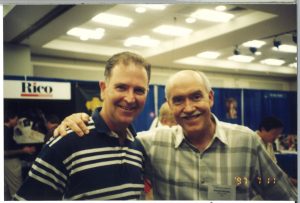
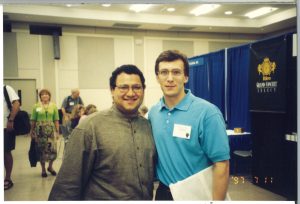
At the exhibit hall at ClarinetFest® 1997 in Lubbock, Texas: David Etheridge and Ramon Kireilis; Ricardo Morales and Jon Manasse
Competitions
Competitions have always been a vital part of ClarinetFest®, going back to its predecessor, the National Clarinet Clinic in Denver. At first there was just one competition, for performers of high school age. During Howard Klug’s presidency (see above), this was split into two: a high school competition for younger performers, with an age limit of 19, and a young artist competition for performers up to age 26. Although age limits have shifted a bit over the years (they are now 18 and 27, respectively), these two competitions continue to this day. In the decade between 1992 and 2002, several new competitions were added. In 1997, the orchestral audition competition took place for the first time. The research presentations begun by Keith Koons in Chicago in 1994 started to be organized as a competition in 1998. The composition competition was initiated in 1993, and although it ceased temporarily after 2001, it resumed in 2010. All of these competitions still exist today. A full list of competition winners may be found on the ICA website at https://clarinet.org/competitions/competition-winners/.
In sum, the period from 1992 to 2002 was one of growth for the ICA, not only in membership but also in mission. Although the decade ended with a dip to just below 4,000 members, that ceiling would soon be broken for good. A new dedication to the ICA’s educational mission characterized this period, along with movement toward a greater role for the ICA in the organization and running of the annual ClarinetFest®. The Clarinet journal expanded greatly to include many more columns, reflecting not only the ICA’s own goals but also the broader interests of the membership. This healthy openness to change, as we shall see in the next issue, would serve the organization well in future decades.
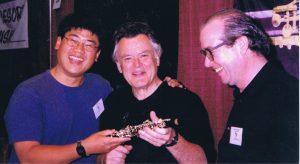
John Bruce Yeh, Karl Leister, and Mr. Wurlitzer at ClarinetFest® 2001 in New Orleans
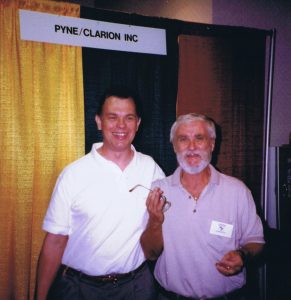
Dan Paprocki and James Pyne at ClarinetFest® 2001 in New Orleans

Al Gallodoro at the exhibit hall at ClarinetFest® 2001 in New Orleans
Endnotes
1 Howard Klug, “The President’s Message,” The Clarinet 20, no. 1 (November/December 1992), 72.
2 Patricia Kostek, “Minutes of the General Business Meeting,” The Clarinet 22, no. 1 (November/December 1994), 57.
3 The original announcement for Klarinet appeared in The Clarinet 20, no. 1
(November/December 1992), 13.
4 F. Gerard Errante, “President’s Message,” The Clarinet 22, no. 3 (May/June 1995), 75.
5 Alan Stanek, “President’s Message,” The Clarinet 24, no. 3 (May/June 1997), 76.
6 Alan Stanek, “President’s Message,” The Clarinet 24, no. 1
(November/December 1996), 85.
7 Patricia Kostek, “Minutes of the ICA General Business Meeting,” The Clarinet 24, no. 1 (November/December 1996), 86.
8 Howard Klug, “The President’s Message,” The Clarinet 20, no. 2 (February/March 1993), 62.
Jane Ellsworth is both a musicologist and a professional clarinetist. She is program director and professor of music history and clarinet at Eastern Washington University. Her books include A Dictionary for the Modern Clarinetist (Rowman & Littlefield, 2015) and The Clarinet (University of Rochester Press, 2021), as well as a forthcoming monograph on the clarinet in 18th- and 19th-century America. Ellsworth is also bass clarinetist with the Spokane Symphony.
Comments are closed.